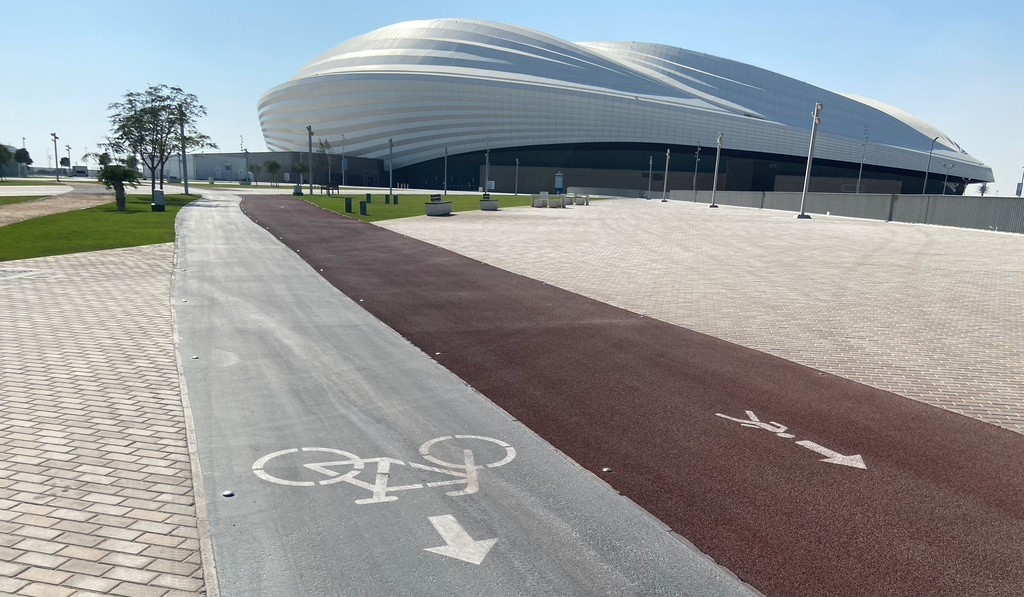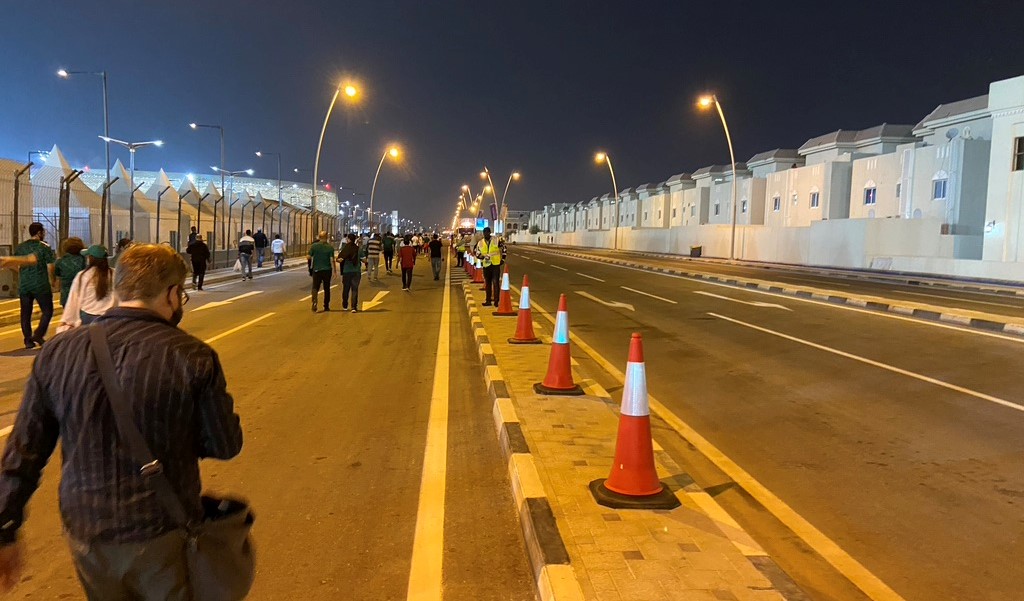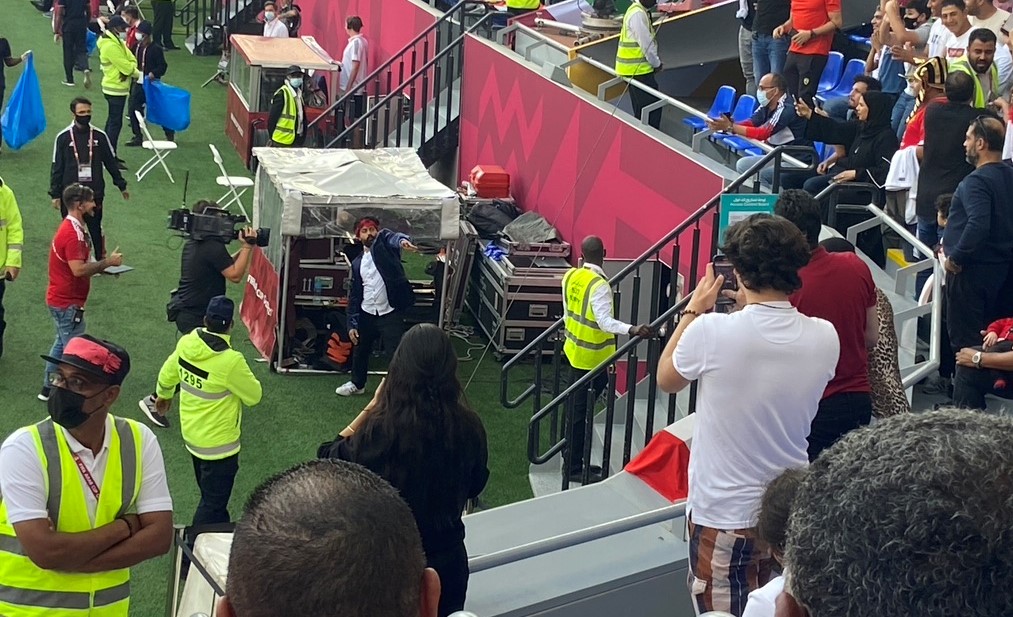Qatar likes to market itself as an open, welcoming society. However, damning reports from NGOs about issues with human rights and freedom of speech in the country have created some cracks in the veneer. The working conditions and terms migrant workers have been subjected to have been referred to as little more than a modern-day bonded-labour system, maintained by large capitalist companies in Qatar and neighbouring states and propped up by the state and the Kalafa system, which actively restricts workers’ rights.
One focal point of criticism levelled at Qatar has been football governing body FIFA’s decision to award hosting rights for the 2022 World Cup to the country. This World Cup, like each of its predecessors, is set to net FIFA USD 3–4 billion, tax free, thanks to the extremely lucrative business concept it has developed.
As has been the case with previous host countries, in Qatar, FIFA has been reluctant to make use of its influence when it comes to rectifying human rights and environmental issues associated with preparations for the tournament.
During our visit, the FIFA Arab Cup 2021 was underway, as a prelude to the most-watched team sports event in the world, with Qatar playing host to sports tourists from a range of countries across northern Africa, the Arabian Peninsula and further afield. We took the opportunity to find out more about the competition arrangements and infrastructure, which were being put to the test for the first time in real-life conditions. Our field research took us to various locations in Qatar, including its capital, Doha, and was carried out on foot, using the brand new shiny metro system, by taxi, in Ubers and by dedicated tournament bus. We photographed the competition venues and other urban building projects, and we interviewed workers, tourists and members of the local population.
Contrary to our expectations, there were surprisingly large proportions of women and children in the stands for matches, with an upbeat, family atmosphere prevailing. Throughout our trip, we made sure that the sense of excitement that hung in the air at this meeting of Arab nations did not blind us to the problematic elements of the event arrangements. Recent news of the detention of two Norwegian journalists investigating the World Cup venues only served to heighten the tension associated with carrying out critical journalism.
Inaccessible stadiums
In terms of its physical geography, Qatar, which is similar in size to the Tampere Region in Finland or the country of Montenegro, is located in a desert. The state, which previously had relatively little to boast in the way of footballing culture, now has no fewer than seven brand new megastadiums either recently completed or under construction for the World Cup. The country has achieved a record-level stadium density given the population size.
The non-existent occupational safety considerations at the stadiums’ construction sites have brought Qatar plenty of negative media attention. According to a report in The Guardian, at least 6,500 construction workers died on Qatar’s worksites in the ten years following the decision to award the tournament to Qatar in 2010.
The state, fearing negative publicity and terror attacks, has ensured that opportunities to visit the stadiums are slim. Due to the security arrangements in place, we were only able to set eyes on the largest new stadium areas from a distance and outside of match times.
The only football shrine built for the upcoming tournament that we were permitted to view up close outside of match days was the Al Janoub Stadium, branded as an ecologically-minded venue and located at the end of the red metro line, to the south of Doha. During our visit, the area was clinically clean, its park and cycling lanes built in the middle of the desert landscape were deserted (as it is, cyclists are a very rare sight in Qatar, despite the weather in December being more bearable for such activities). It appeared that wider-scale residential construction in the area had yet to get underway.

Attempts to further explore the areas around three other stadiums proved unsuccessful. One of these was the campus-esque themed area around the Education City Stadium, which is managed by the Qatar Foundation and located in close proximity to the campuses of a number of well-known American and British universities. As we approached the stadium, a security guard appeared, telling us that taking photographs was prohibited and asking us to leave.
Even more difficult to get to were Ahmad Bin Ali Stadium and the main stage for the World Cup, Lusail Iconic Stadium. Both were surrounded by metal fences, concrete barriers and ‘access prohibited’ signs hundreds of metres out from the stadium. The atmosphere was intimidating; even taking photos from the window of the taxi felt almost criminal.

The huge-scale stadium construction efforts in Qatar have been lauded as ‘sustainable development’. One key element of the marketing for the World Cup has been the modular architecture, which, in principle, allows for the stadiums to be dismantled and moved to other locations within or beyond Qatar with minimal technical effort.
However, the concept of sustainable stadium construction is surrounded by a haze of marketing-oriented mumbo-jumbo. In sustainability calculations, the negative sustainability impacts of factors such as air conditioning, movement of the modules, and rebuilding of the venues have been ignored. Qatar’s Ahmad Bin Ali Stadium is a shining example of this – it must be some kind of record that the plot allocated for this grand new stadium previously housed a stadium that was only completed in 2003, before being demolished to make way for its successor.
Greenwashing and sportswashing its way into investors’ wallets
On our way to the stadium sites, we could not help but notice the hundreds of construction sites and thousands of cranes dotted across the landscape throughout Qatar. According to international workers’ rights organisation Building and Wood Workers’ International’s General Secretary Ambet Yuson, only six per cent of all construction projects in the country are directly linked to the preparations for the World Cup. Other significant investments in infrastructure, luxury residences, and entertainment oases form part of Qatar’s attempts to develop itself into a world-class business and tourism hub in the style of Dubai or Abu Dhabi. The brand dream of Qatar as a globally attractive hub for sports forms a key part of this growth machine and is pivotal to its credibility following on from the football World Cup.
There are mega building sites recently completed and still under construction throughout Qatar. For example, a new urban centre has sprung up to the north of Doha’s old town, across the bay. A ‘downtown-style’ banking and office district characterised by dozens of skyscrapers is something of an obligatory landmark in any city worth its salt these days throughout Asia.
Further north is The Pearl-Qatar, a partially finished, luxury seafront residential district. The Pearl-Qatar is an artificial island development that ‘rose from the sea’, with the different islands and quarters inspired by themes derived from Arab and European cultures, cities and symbols, aiming to attract ever richer foreign residents and property investors.
The most expansive of the construction projects in the north of the country that appear to have ‘risen from the desert’ is Lusail, a new city that is largely still under development and will, when finished, be similar in size to Tampere in terms of number of residents. Lusail is a vast project coordinated by a subsidiary of the Qatar Investment Authority, which is itself managed by the inner echelons of the Al Thani family. Stories of countless cases of labour exploitation on the construction sites in the area have leaked to the press.
Just within Lusail is the stadium that will host the World Cup Final, a stadium that we only managed to see from the window of a bus at some distance.

Half an hour’s drive from Lusail is Al Khor, where a stadium with a capacity of 60,000 and reminiscent in design of a Bedouin tent was completed on the eve of the FIFA Arab Cup. The urban construction underway on the northern periphery of Qatar was otherwise somewhat less megalomaniac in nature than that in Lusail and the southern parts of the country.
The rate of construction in Qatar at the moment is amongst the most intense anywhere in the world. We could not help but wonder what resources it has taken to create this nationwide construction site in the middle of a desert. Where do all the residents, users and investors come from for Qatar’s seemingly endless property investment sites?
Without the natural gas and oil reserves Qatar sits upon, the desert would not be transforming into a Las Vegas-style entertainment oasis. However, the petrochemicals being pumped from the bowels of the country will ultimately run dry, and so the state is also creating other foundations upon which to build its future. Property development occupies a strategic position here – creating credible investments primarily for international investors. In the modern world, combining land and property holdings and debts with the financial markets breeds speculative urban development, of which Qatar is a stand-out example. Credibility requires huge investments. New and still-under-construction world-class sports infrastructure, vast entertainment events and greenwashing and sportswashing, which are both widely practised throughout the country, all form part of this credibility house of cards.
The Qatar National Vision development programme was drawn up with 2030 as its target year and features goals including becoming a globally attractive luxury accommodation, tourism and investment destination.
Qatar’s political and financial elite are intertwined in many ways with the world’s megapowers and major global financial players. As long as the brand retains its credibility, money will continue to beget money. Corrupt FIFA, its reputation in need of some serious polishing, is one of Qatar’s most globally significant partners in all of this. The investment boom is, in Qatar, at the same time a major marketing effort that the World Cup is doing more than its share to accelerate.
Obligatory carnival atmosphere
When putting themselves forward to host the football World Cup, the candidate countries are required to provide FIFA with commitments regarding tax relief, security arrangements, rights and visibility of selected sponsors, and, in general, realisation of the event format in accordance with the FIFA concept during the event arrangements. The successful organiser is required to commit to the promises made in its application, one of which is the creation of a positive carnival atmosphere surrounding the football.
Being chosen as hosts for 2022’s football mega event was like hitting the jackpot for Qatar’s ruling political and financial elite: a matchless opportunity to showcase the country and its numerous construction projects. Of utmost importance is ensuring that the event goes as well as it possibly can, in everything from the functionality of the transport infrastructure to guiding the masses of spectators around the venues and country, and the gripping carnival atmosphere before matches, designed to grow as spectators near the stadium.
The 2021 FIFA Arab Cup was a pre- and test-tournament for this. We saw three new stadiums and their surroundings during the matches we had tickets for: Stadium 974 – which is constructed partially of shipping containers, Al Thumama Stadium, and Al Bayt Stadium in the ‘countryside’ to the north of Qatar. Based on what we saw, the event arrangements at this pre-tournament adhered to the concepts tested at earlier FIFA tournaments.
All three matches were very carefully orchestrated affairs, and at their core, commercial entertainment events, with the cosmopolitan nature of football with an ‘Arab twist’ harnessed for the purposes of the country’s branding and property marketing needs.
One good example came in the form of the public transport arrangements for the semi-final between host country Qatar and ultimate tournament winners Algeria. During and prior to the match at Al Thumama Stadium, we experienced possibly the most sports hubbub of the tournament. Spectators were not given the chance to stray from the route from the Free Zone metro station to the stadium. The stewards were equipped with giant foam hands, with the extended oversized fingers directing visitors comedically in the right direction. A fleet of more than 150 luxury buses was waiting in the metro station’s carpark for the football fans. The bus journey took us along motorways cleaved through the as-yet undeveloped desert landscape to another carpark, from where it was a further couple of kilometres on foot to the stadium.
This ‘last mile’ was routed through a newly constructed, seemingly deserted residential area. As evening fell, we saw lights, furniture or moving supplies in only a handful of the apartments we passed. And we did not see any residents whatsoever. A sole beautician’s studio was seemingly the only permanent and open business along the dedicated route erected for this football carnival. The impression was that of a ghost town, bringing to mind Potemkin Villages erected to boost property sales.

Closer to the stadium, music intended to get us pumped up was being blasted at high volumes. Ethnic percussion groups encouraged fans to get carried away dancing and celebrating. The majority, however, contented themselves with just taking photos of the festivities. At last, Al Thumama, reminiscent of a traditional woven gahfiya cap, appeared in front of us. The stadium area itself was dotted with a number of displays on themes of Arab culture, including a dance and song performance by men clad in the traditional white thobe robes.
The atmosphere building efforts at the bronze medal match between Qatar and Egypt at Stadium 974 was similarly impressive. Along the kilometre-long pedestrian route, the stewards – so-called ‘last mile marshals’ – threw themselves whole-heartedly into attempts to get us going, swinging their hands and hips, rhythmically repeating “Are you ready, are you happy?” The atmosphere at the bronze medal match was not particularly rambunctious, but stewards serving as kind of tournament brand ambassadors were nothing if not persistent in their attempts to rouse the requisite atmosphere amongst spectators. Evidently, this sense of excitement was not just about the match about to start, but also extended to the World Cup to be played at the end of 2022.
The carnival concept created for this pre-tournament also included a number of interesting elements during the football, too. At each of the matches we attended, we saw the same audience-hyping, overly energetic, Rambo bandana and blue velvet sports jacket clad individual. This master of ceremonies was a kind of microphone-equipped cheerleader on a stadium-wide scale. Everywhere he went, he was followed by a dedicated camera man, relaying atmospheric images to the big screen and presumably also the television broadcasts. Every time this master of ceremonies appeared in a different part of the stands, hundreds of smartphones came out, snapping photos of the performer. For lots of our fellow spectators, following this side show and social media check-ins seemed to be a higher priority than the match itself.
The DJ playing music in the upper stands also made appearances on the stream shown on the jumbotrons. The impression was similar to that of the many ‘carnival atmosphere’ sports events centred around entertainment and cameras that are also popular in Western countries.

Digital discipline and freedom of speech issues in Qatar
So, what about the other problems we encountered, the flip side of this Qatari dream?
Qatar is not a democracy, although it happily fraternises with plenty of Western democracies. NGOs are banned in the country and only state-run organisations and for-profit businesses are permitted. Somewhat unusually, the International Labour Organization (ILO) has been granted permission to set up an office in Qatar.
In the face of international pressure, in recent years the rights of migrant workers have been set out in law, but abolition of the Kafala system, which effectively enslaves workers to their employers, has not progressed from legislation into practical measures. Camps housing migrant workers are located outside the cities, and outsiders are not allowed in to see the conditions of these sites.
One of the more interesting parts of our trip was interviewing migrant workers in low-paid sectors. Almost nine in ten residents of Qatar are migrant workers, the majority coming from various countries in Asia and Africa. This pariah class lack almost all civil rights. The primarily male migrant worker population work largely on the countless building sites in Doha and the surrounding countryside (approx. one million construction workers without civil rights) and in the service sectors.
The taxi and Uber drivers we chatted with told us that they sent their earnings back to their families in their home countries. Legislation offers only the very few migrant workers who have become rich the right to live in Qatar with their families.
A migrant worker told us that his cousin had died in an accident on a World Cup venue building site. According to him, Qatari media maintains a veil of silence about these deaths and families’ complaints.
However, very few migrant workers will criticise their working conditions and lack of civil rights publicly. A very efficient way of dissuading people from stepping out of line is the so-called red stamp. Even the most minor criminal offence will result in a red stamp in the passport of migrant workers, which in practical terms means a ban on working and supporting their families not just in roles on Qatar’s construction sites and in its service industry, but also those in other super-rich states on the Arabian Peninsula.
Qatar and the promises it made FIFA make much of the country’s ‘safe’ conditions. One local we interviewed claimed that in Doha, “there is no crime, because the police would be there in a minute”. According to our informant, surveillance cameras are everywhere.
At the football matches too, we got first-hand experience of the mechanisms of this security undertaking. Even at the pre-tournament, the Qatari organisation machine was clearly trying to meet the promises made to FIFA when it comes to security at the tournament. The only way to access the matches was through several digitised inspection points, requiring attendees to present not just their tickets but also their Ehteraz pass to demonstrate a negative Covid-19 test result.
When attending the matches we also encountered some of the more absurd elements of the security machine. At one security check point, our pencil was confiscated. When we explained that, as journalists, we need our tools of the trade, we were told that taking notes was prohibited!
The all-encompassing digitalisation also appeared to be a key tool in building an extremely secure Qatari state. Doha is one of many cities that have invested substantially in digital infrastructure and branded themselves as a smart city, with digitalisation helping to produce a constantly updated information and security infrastructure.
Being a digital pioneer also requires residents and tournament visitors to embrace a certain kind of ‘smart’ digital urbanism. We had the dubious pleasure of experiencing this in a number of ways. “There are no post-boxes in Qatar” an airport worker finally explained, when we found ourselves searching for one in vain to post our postcards from the Souq Waqif bazaar (where postcards are still being sold).
Digitalisation – or more accurately its non-functionality – brought with it a number of other annoyances. Trying to persuade the endless number of apps to work at the required times also proved something of a Sisyphean task, with apps to enter Qatar, the Doha metro, shops and matches all mandatory. The Ehteraz app – a local Covid-19 passport – required location data to be turned on, which in turn drained the phone’s battery at an impressive speed. To access match tickets, spectators had to download the FIFA app. The Hay’ya app was also forced upon us, which supposedly offered perks such as showing the fastest route to your desired stadium, however our efforts to get it to work proved in vain. Seemingly the organisation machine still had a way to go with the testing phase when it came to information and security solutions.
Dissenting voices suppressed
Qatar is a successful yet humble model student of the world capitalist economy, simultaneously promoting Islamic cultural traditions and Western consumption ideals and values, while the political elite follow the doctrines of ultra-capitalism. Alongside the local language, Arabic, the supremacy of English as a global business language is visible everywhere. On the flip side of all the security measures, the ruling Al-Thani family, who practise authoritarianism in the country, and the brands of the plutocracy, adorn the facades of buildings. In an attempt to polish their image, after our visit the state of Qatar and FIFA offered migrant workers access to advance sales of World Cup tickets at a reduced price of ten euro.
None of this should come as any surprise following the decision to award Qatar hosting rights for the biggest sporting mega-event in the world. The pre-tournament we attended demonstrated that there are glaring contradictions between FIFA’s money-hungry approach and the rhetoric of equality between the nations championed by FIFA. Previous World Cups held in South Africa and Brazil in recent years attracted large-scale protests against this corrupt organisation and problems with the related construction projects. Even the final match of the World Cup in Russia in 2018 was interrupted by a pitch invasion by members of activist group Pussy Riot, and for a moment, criticism of Putin’s security machine interrupted the TV coverage.
If our predictions are right, in Qatar we can instead expect World Cup matches that proceed without interruption or dissenting voices, at least at the venues. The country’s objective is to have a ‘brilliant tournament’ and boost the Qatari growth machine’s traction and credibility even further within global markets.
Artikkeli on osa Särö Global -juttusarjaa, jossa julkaisemme eurooppalaisten kulttuurilehtien artikkeleita suomeksi ja käännätämme Särön artikkeleita muille kielille. Artikkelin suomenkielinen versio on saatavilla täältä.

